|
Corsair Marine kicked off 1997 by entering production with a brand new model in its line of folding trailerable trimarans. The Corsair 28 (shown here) and Corsair 28R are now the the mid-range mainstay of Corsair, which also produces the Corsair 24 Mk.II and several models of the Corsair 31 trimarans. The new Corsair 28 models have superceded the famous F-27, which enjoyed an 11-year production run at Corsair.
In 2000 Corsair Marine introduced the 28' Center Cockpit model. Click here for all the details on this exciting trimaran.
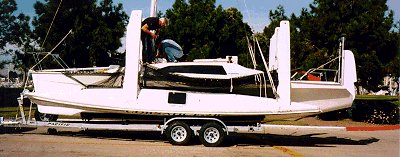
The Corsair 28, like all of its predecessors and current sisters, is an easily trailerable sport boat because of its light weight and low profile on the trailer. Here the mast has been raised and final preparations are being made to launch the boat. As with other Corsair trimarans, the transition from trailering to sailing only takes about 30 minutes.
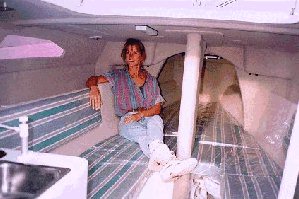 Roomy Interior Roomy Interior
The Corsair 28 and Corsair 28R have roomy, functional interiors with all the necessary amenities for comfortable overnight cruising. There are sleeping accommodations for four, galley area with 2-burner stove, stainless steel sink, fresh water tank and pump, and a marine head with privacy curtain and a holding tank. Seat/bunk cushions are standard and are available in over 40 colors and patterns, or may be covered with customer-supplied fabrics as desired.
Ready for Launch
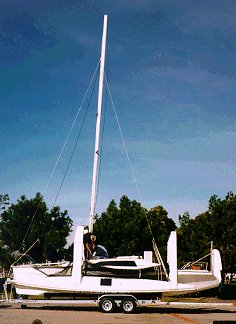 Mast up and ready to launch, this is the standard Corsair 28 showing the rakish aluminum rotating rig. The "R" model sports a taller but lighter weight rotating carbon fiber mast of airfoil section. The mast is raised or lowered using the installed winch on the trailer. This is a straight forward operation that can be accomplished easily in a few minutes, even with only one person. Everything about the Corsair 28 is designed to get you on the water quickly. The carbon fiber mast of the Corsair 28R has the double advantage of being more efficient and powerful on the water and of less weight for easy handling on the trailer. What appears to be an aircraft's verticle stabilizer in this photo is actually the rudder, which pivots up 180-degrees for trailering. This and the fully retractable daggerboard also enable you to pull in close to shore and anchor in knee-deep water, or even put the Corsair 28 onto a sandy beach. The rugged dual axle galvanized steel trailer will provide many miles and years of trouble free trailering. Surge brakes, lights and spare wheel are provided. Full up gross towing weight, including boat, trailer and essential sailing gear, is only 4,400 pounds. Mast up and ready to launch, this is the standard Corsair 28 showing the rakish aluminum rotating rig. The "R" model sports a taller but lighter weight rotating carbon fiber mast of airfoil section. The mast is raised or lowered using the installed winch on the trailer. This is a straight forward operation that can be accomplished easily in a few minutes, even with only one person. Everything about the Corsair 28 is designed to get you on the water quickly. The carbon fiber mast of the Corsair 28R has the double advantage of being more efficient and powerful on the water and of less weight for easy handling on the trailer. What appears to be an aircraft's verticle stabilizer in this photo is actually the rudder, which pivots up 180-degrees for trailering. This and the fully retractable daggerboard also enable you to pull in close to shore and anchor in knee-deep water, or even put the Corsair 28 onto a sandy beach. The rugged dual axle galvanized steel trailer will provide many miles and years of trouble free trailering. Surge brakes, lights and spare wheel are provided. Full up gross towing weight, including boat, trailer and essential sailing gear, is only 4,400 pounds. 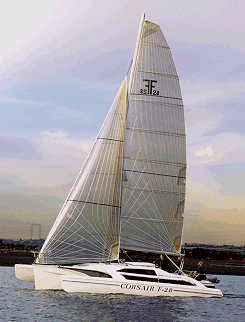 Photo by David Shuler
First Photos Under Sail
The standard Corsair 28 under sail during its sea trial in early '97. Sails offered by Corsair are mylar-based "Tape Drive" sails by UK Sailmakers. These feature a Technora scrim and a system of Polyester and Kevlar tapes arrayed along the natural lines of stress in the sail material. This Corsair 28 has an aluminum rotating mast supplied by Ballanger Spar Systems of Santa Cruz, California. The masthead is approximately 37 feet above the deck. (In this photo it appears to be proportionally shorter than normal because of the wide angle lens that was employed in taking this photograph.) The Corsair 28R (race version) has a carbon fiber rotating mast that is 1-1/2 feet taller than the standard version. The carbon mast has an airfoil shaped cross section and is supplied by the Omohundro Company of Minden, Nevada. Both versions feature a roller furling/reefing boom, which has proved very popular on earlier Corsair trimarans such as the F-27. Beyond the choice of masts, Corsair 28s and Corsair 28Rs are identical in all respects.

Fast and Easy Under Sail
The new Corsair 28R with carbon fiber rotating mast punches effortlessly through choppy seas at over 14 knots with main and jib alone while sailing nearly level.
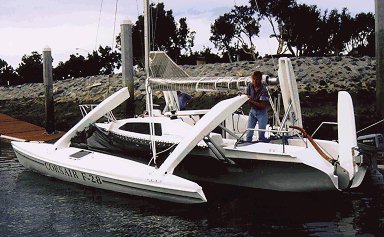
Folding is Easy
Once in the water, folding the floats is quick and easy. It only takes a minute or two and is managed readily by one person. The nets tension themselves automatically as the floats are unfolded. No other adjustments are required. Notice the kick up rudder blade in the vertical position. The mainsail is rolled on the roller furling boom and is ready for hoisting.
Specifications
Design specifications and line drawings are available here.
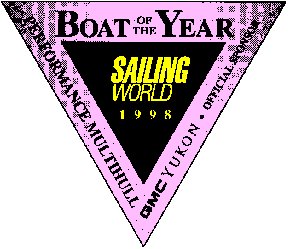
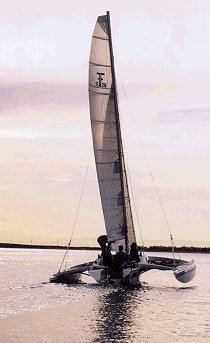
|

 Corsair 28
Corsair 28 
 Corsair 28
Corsair 28